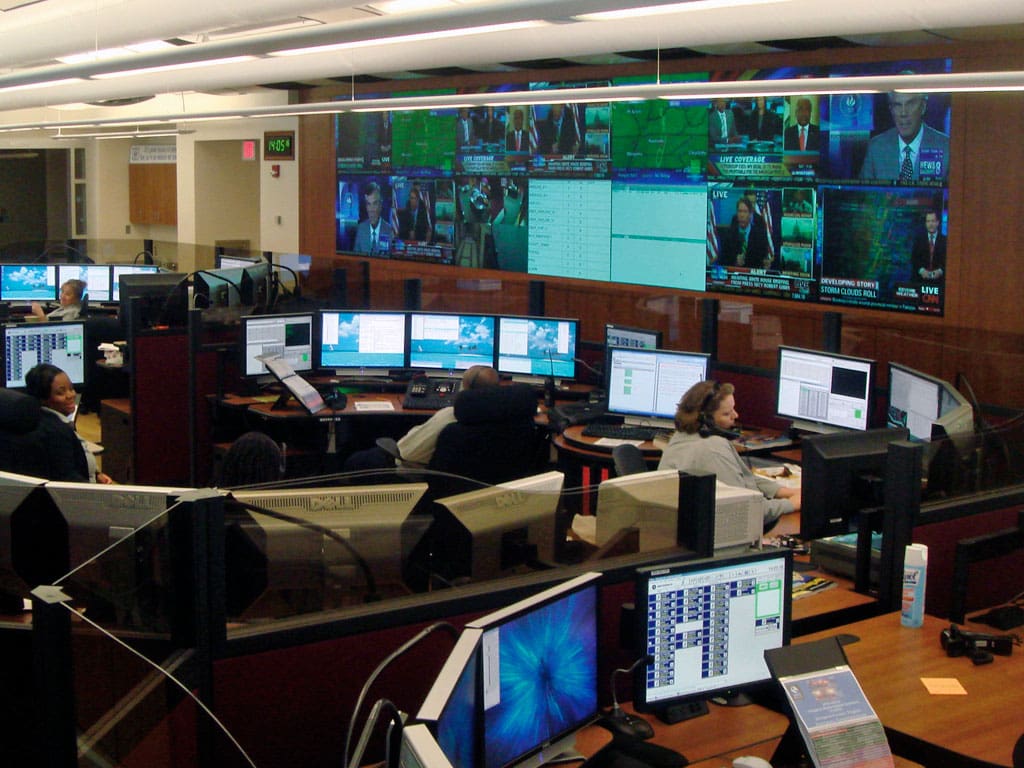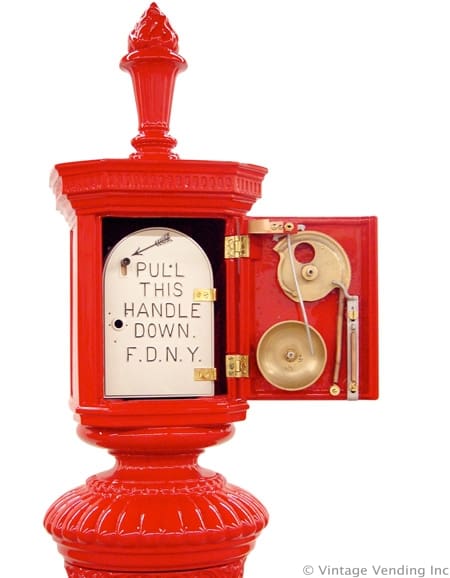The 911 Emergency Response System works because of one thing and one thing only: the 911 dispatcher. They have an uncanny ability to bring order to chaos, calm the hysterical, and prescribe just the right number of resources for an emergency situation. Unfortunately, as an article in Radio Resource Magazine points out 911 call volume is increasing while the number of available operators have been decreasing, meaning citizens can expect to be on hold as long as EIGHT MINUTES before even talking to an operator. Why is this happening and what does this mean for you?…
The reason for that increase is probably in your pocket right now — a cell phone.
The first “modern” dispatch system for firefighters and police were a series of mechanical boxes strategically placed on street corners around the city they were covering. If there was a fire or the citizen needed police assistance they would run to the nearest box, pull the handle inside, and a signal would be sent to the closest station to dispatch units. Each box was uniquely numbered so the responding units knew exactly where the call came from. To this day major metropolitan areas are still divided into “boxes” so responders know which way to head from their station when they get a call, and while the boxes themselves may be long gone their numbers remain.
Ambulance 422 Echo, box 2208 for a BLS emergency…
With the increased adoption of the telephone citizens began calling their local fire station or police station directly rather than running and pulling the box handle. Up until the 1950s most telephone calls were placed by operators, so simply picking up the phone and stating what you needed was enough to get help rolling. Once operators became a thing of the past a standard emergency number was chosen and localities set up Public Safety Answering Points (PSAP), also known as 911 call centers, to handle calls and dispatch resources.
The original staffing requirements for these stations were decided when landline telephones were the norm. A family of four might have only one line for the entire household, meaning probably only one call per emergency. With the advent of the cell phone the math changed completely. Even a small event like a fender bender accident could bring in 20 to 30 calls from passing motorists, tying up resources (operators) that could be taking calls from new situations. Even worse, with the recent budget issues the country is facing call centers have been seeing staff reductions.
The “perfect storm” of increased call volume and fewer staffers means that if you call 911 on a busy night there’s a good chance you’re going to be on hold, which is the last thing you want to hear if there’s someone breaking into your house in the middle of the night.
Here are three tips to help you skip the line and make it through the night:
- Assume help is more than 15 minutes away. Even if you immediately talk to a 911 operator and they dispatch someone right away, it still may take time for them to get to you. Until you see those lights outside your window you’re on your own. For medical emergencies, apply direct pressure to any bleeding wounds and put the patient in a position of comfort. If there’s an immediate threat that requires police intervention either get out of the house or retreat to the furthest away point, preferably with a shotgun.
- Know the direct number for your local emergency services. Even though we have 911 dispatchers these days police and fire stations still have someone staffing their phone 24 hours a day, 7 days a week. Figure out which are the closest police and fire stations to you and ask them for their direct phone numbers for the station. This can sometimes shave minutes off the wait time compared to calling 911, but if you can stand the wait 911 is still the best option for getting the help you need.
- Do it yourself. If you’ve got a medical emergency on your hands and the ability to drive to the hospital, GO. Recent studies showed no significant difference in the outcome of patients transported in the back of a police cruiser (without medical help) and those transported by ambulance. The faster you can get to definitive care (a hospital) the better the outcome will be. If the problem is the kind requiring police intervention, however, the legal ramifications of “doing it yourself” may be prohibitive. But if your life is in danger, do everything you can to protect yourself. Again, the best option is often running away.
Self sufficiency is always the best policy. If the only person you need to rely on in an emergency is yourself then you have a better chance at making it out alive and in one piece. Even 911 call centers can experience outages, so make sure you have at least two ways to contact help and make sure you have at your disposal the means to deal with anything for at least 15 minutes.
And if you have the opportunity, make sure to raise your voice in support of staffing at 911 call centers.






I read an interesting article on the 911 system. It offered that the entire system needs a radical rethink, because of the evolution of the phone system, away from POTS (land) lines and towards mobile phones. The article cited the case of a military wife who dialed 911 to report her husband was attacking her. Problem was, 911 rang to the dispatcher a few blocks from her home. But they weren’t home – they’d been transfered to Korea. Even worse, the wife couldn’t give the 911 operator an address.
I’m thinking this is not gonna be an easy fix, and it’s probably going to involve more than just GPS or cell tower triangulation.
From the picture in the article it would look to an easy start would be to stop wasting assloads of money on useless IT projects. A series of projectors on the wall, the majority of which are displaying national news, every dispatcher having 4 monitors when only 1 or 2 are needed.
As a guy who works on computers daily, I can tell you that two monitors is the bare minimum. Considering the amount of information dispatchers have coming at them, I think having four is completely justified.
Looks eerily similar to the CAOC I used to work in. Having the news on is important in getting information on major incidents. Considering the high-stress job the 911 operators are in, this looks like a reasonable set up. The circular desk design fosters communication between dispatchers and ease of viewing from one desk to the other.
Personal Story.
When I was around the age of ten, my dad and I were taking down a beam structure in our back yard. My father had just unbolted one corner and was holding the crossbeam in his hands when it slipped out. The 2×4 swung down (it was still attached to the other side) and clonked me in the side of the head, just in front of my ear. I was conscious, cognitive, and not bleeding. But I was ten and had already suffered a handful of head injuries throughout childhood. We called 911. In the past I had been directly taken, but this time I wasn’t for some reason.
After the call, my parents called our neighbor, a high-up trauma ER doctor. He was in the ER at the time, but was about to leave. Within 15 minutes he was in our living room giving me a field neurological exam. I was fine, lumpy, but fine. As he was leaving, we heard the sirens coming down the street and we called the operator and called off the ambulance to avoid the $200 dollar taxi. When seconds count, the ambulance if only 35 minutes away. Lucky for me I got a hard head.
For a fairly chilling look at the problem read the book “Dial 911 and Die”.
When I dial those numbers, I get a call center 54 miles from my house – and that’s pretty close by AK standards. We have I think 5 troopers now who cover an area of 10’s of thousands of square miles. They patrol 5 towns (6 during tourist season) and they are obviously not all on duty at any given time. So we count ourselves fortunate when they are within 30-60 minutes.
Ambulance and fire department are different. We have local volunteers that are skilled and actually care. One problem is that they are not to approach certain situations without trooper support. Another problem is they only have one ambulance and limited equipment. The closest hospital is 54+ miles away. If the roads are good, it can be driven in about 35 minutes.
All these are reasons why we don’t typically call 911. If we have a medical need, we call a good friend who is a local EMT – same for fire as he is a volunteer firefighter. If a trooper is needed, well it better be for the aftermath or you are the aftermath he has to deal with.
I should add, our local troopers are good folks. I have needed their help our advice more than once. They have always treated us well and we’ve not gotten any vibe that they see us as a threat. That doesn’t mean I don’t act with some common sense and self-preservation. I just like to point out that not all LEOs are the same. We have some good ones, we know it, and we try to treat them well.
If you are bleeding, your best bet is to jump in the nearest car and get to the ER, hopefully with a friend driving.
Hopefully after you pressure-bandaged the wound or dumped Quick-Clot on it to stop/slow the bleeding.
I seem to recall an entry in the Congressional Record some years back that in Miami Dade a third of all 911 calls were never even answered. There was also a breakdown on the time to respond. Some were response times were in minutes. Some in hours. Some the next day. And some were never responded to.
When it comes to 911, you’re on your own.
Comments are closed.